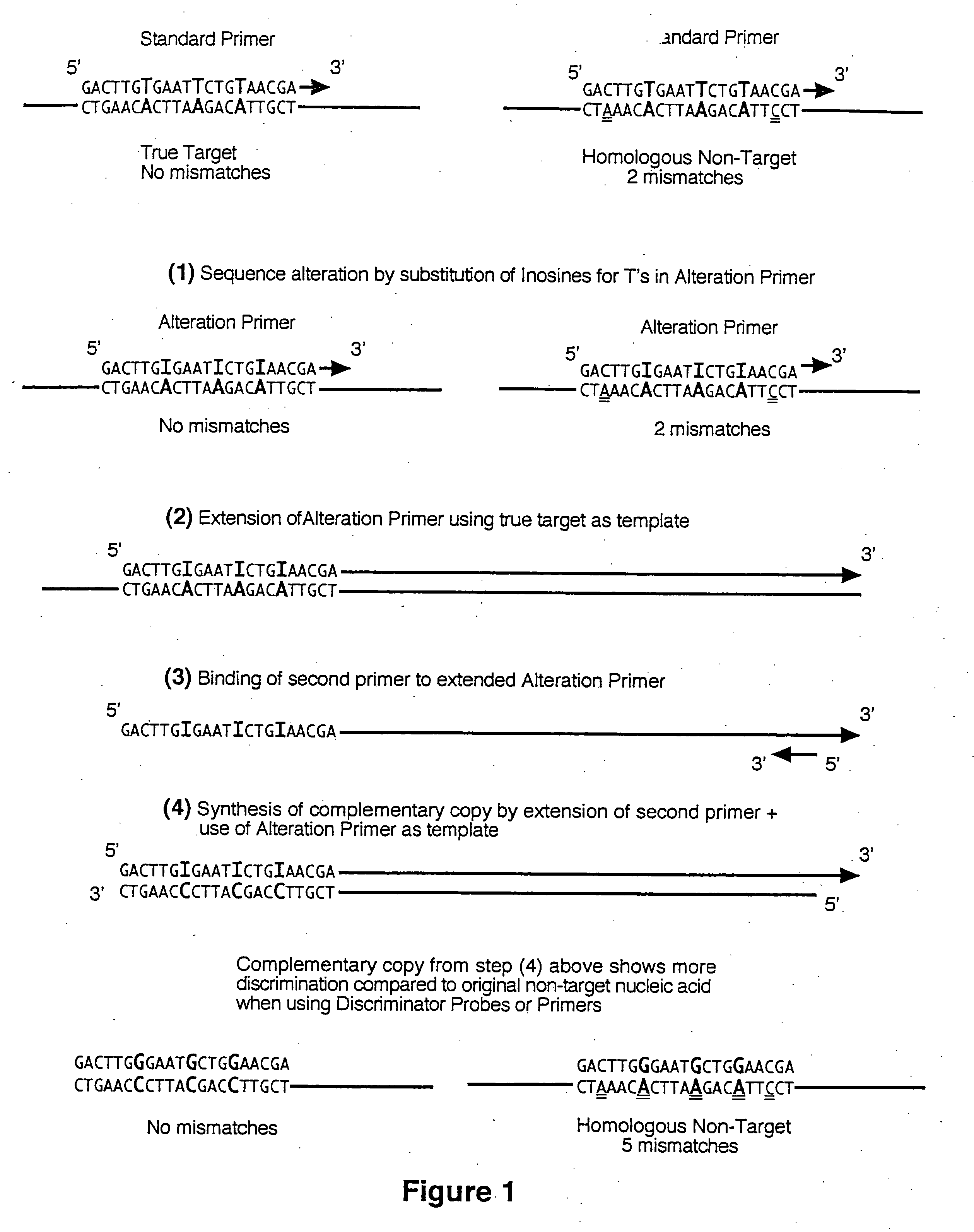Selective detection of oncogenic HPV
a technology of oncogenic hpv and detection method, applied in the field of epidemiology, can solve the problems of increasing complexity, large risk factor in the likelihood of cervical carcinoma development, and large number of separate probes at the same tim
- Summary
- Abstract
- Description
- Claims
- Application Information
AI Technical Summary
Benefits of technology
Problems solved by technology
Method used
Image
Examples
example 1
Selection of Conserved Differential Sequences from the E6 Gene
[0097]A) HPV 16 Cluster
[0098]Region E6-16-1(a) [Starting at Nucleotide 314]
16TCTAAAATTAGTGAGTATAGACATTATmismatches35--A-----A-----A------TGG---631--A---G-A-----A-T----TGG---852-----G--A-----A-----G------433--------------A------------158--------AG-----------------26GGA-----A-ACC-A--------C-T-1011GGG-------ACC-A--------C-T-942---------T---CACTGC---C--C943GGA------A--C-A-----G--C-T-944GG---GG-C-A-C-A-T---G----T-11
[0099]Potential Consensus E6-16-1(b)
TCTAAAATTAGTGAATATAGACATTAT16--------T-----G------------252-----G--------------G------233--------T------------------158---------G----G------------26GGA-------ACC----------C-T-811GGG-----T-ACC----------C-T-942--------TT---C-CTGC----C--C943GGA---------C-------G--C-T-744GG---GG-C-A-C---T---G----T-8
[0100]For consensus sequence E6-16-1(b), the lowest match with HPV 16, HPV 33, HPV 52 and HPV 58 is 25 out of the 27 bases; the highest match for HPV 6, HPV 11, HPV 42, HPV 43 and HPV 44 is...
example 2
Amplification Using Oncogenic HPV E6 Gene Sequences from Example I
[0140]A) Selection of Consensus Sequences from Example 1
targetscrossreactionsForwardE6-16-1(b)16, 33, 52, 58E6-16-1(c)31 and 35E6-18-1(b)18, 45 and 59E6-18-1(c)39 and 6870E6-51-1(b)51 and 5666ReverseE6-16-2(c)16, 31, 33, 35, 52 and 58E6-18-3(b)18, 45 and 59E6-18-3(c)39 and 6870E6-51-2(b)51 and 5653 and 66
[0141]B) Selection of Consensus Sequences from Consensus Sequences of Example 1
Forward Primer Sequences
[0142]
Primer FP-1TCTAA AATAA GTGAG TATAGACATT ATSourceE6-16-1(b)targets16, 33, 52 and 58minimal target match25 out of 27maximal non-target match20 out of 27Theoretical Tm64° C.Primer FP-2TCAAA AGTAA GTGAA TATAGATGGT ATSourceE6-16-1(c)targets31 and 35minimal target match26 out of 27maximal non-target match17 out of 27Theoretical Tm68° C.Primer FP-3CGACC CTACA AACTA CCTGATTTTG CASourceE6-18-1(b)targets18,45 and 59minimal target match24 out of 27maximal non-target match15 out of 27Theoretical Tm78° C.Primer FP-4CATAC AA...
example 3
Selection of Conserved Differential Sequences from the E7 Gene
[0145]A) HPV 16 Cluster
[0146]Region E7-16-1(a) [Starting at Nucleotide 617]
16CAACTGATCTCTACTGTTATGAGCAATTmismatches35-------C--A-----------------231-------C---C----------------252-------C--AC----C-----------433-------C--A-----C-----------358-------C--A-T---C-----------4 6-TGTA-GGT-AC-T--C-----------11 11-TGTA-GGT-AC-T--C-----------11 42-CAT---C--G--T--C-----A-----844-TGTA-GC--AC-T--CA----------11
[0147]Potential Consensus E7-16-1(b)
CAACTGACCTCTACTGCTATGAGCAATTmismatches16-------T--------T-----------235----------A-----T-----------231-----------C----T-----------252----------AC----------------233----------A-----------------158----------A-T---------------2 6-TGTA-GGT-AC-T--------------10 11-TGTA-GGT-AC-T--------------10 42-CAT------G--T--------A-----644-TGTA-G---AC-T---A----------9
[0148]For consensus sequence E7-16-1(b), the lowest match with HPV 16, HPV 31, HPV 33, HPV 35, HPV 52 and HPV 58 is 26 out of the 28 bases; the hig...
PUM
| Property | Measurement | Unit |
|---|---|---|
| temperature | aaaaa | aaaaa |
| temperature | aaaaa | aaaaa |
| temperature | aaaaa | aaaaa |
Abstract
Description
Claims
Application Information
 Login to View More
Login to View More - R&D
- Intellectual Property
- Life Sciences
- Materials
- Tech Scout
- Unparalleled Data Quality
- Higher Quality Content
- 60% Fewer Hallucinations
Browse by: Latest US Patents, China's latest patents, Technical Efficacy Thesaurus, Application Domain, Technology Topic, Popular Technical Reports.
© 2025 PatSnap. All rights reserved.Legal|Privacy policy|Modern Slavery Act Transparency Statement|Sitemap|About US| Contact US: help@patsnap.com



